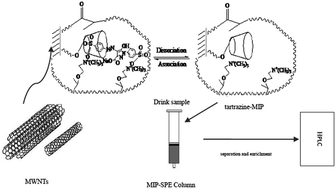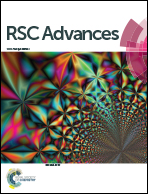Bifunctional monomer molecularly imprinted polymers based on the surface of multiwalled carbon nanotubes for solid-phase extraction of tartrazine from drinks
Abstract
A novel composite material consisting of multi-walled carbon nanotube (MWNTs)-molecularly imprinted polymers (MIPs) for a tartrazine assay was synthesized by a surface molecular imprinting technique. The molecularly imprinted polymers were prepared with beta-cyclodextrins and [2-(methacryloyloxy) ethyl]trimethylammonium chloride (DMC) as bifunctional monomers. The MWNTs-MIPs were characterized using transmission electron microscopy (TEM) and Fourier transform infrared spectroscopy (FT-IR). Adsorption experiments showed that the MWNTs-MIPs exhibited a high capacity and favourable selectivity toward tartrazine, and the maximum adsorption capacity, qm, and distribution coefficient, kd, were estimated to be 135.15 mg g−1 and 14.72, respectively. A SPE-HPLC analytical method was developed and used to assay tartrazine in five drinks. The recoveries were in the range from 88.6–102.4% with a relative standard deviation below 5.0%. The tartrazine content was lower in all samples than the permitted maximum limit set by the European Commission and Ministry of Health of the People’s Republic of China. A t test demonstrated that this method had no significant difference to the Chinese standard method of GB/T 5009.35-2003 at P = 0.95.


 Please wait while we load your content...
Please wait while we load your content...